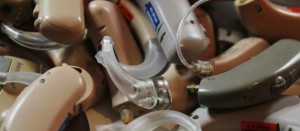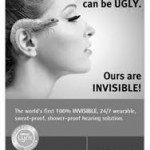The pressure on audiologists to become glorified salespeople on behalf of hearing-aid companies reveals an ugly side of what used to be a dedicated public service.
Almost everyone I know who has ever worked in organisations for deaf and for hearing-impaired people has heard stories of hearing clinics which badger hearing-impaired people into buying expensive hearing aids which are more than what they need. The ABC Radio National program ‘Background Briefing’ expose on the pressure on people in many private hearing clinics to meet sales targets for hearing aids is a sobering example of ugly capitalism leaching into what used to be a service to the public. Presented by Hagar Cohen, read the transcript of Have I got a hearing aid for you
 Australian Hearing is the national hearing-care body established by the Commonwealth Government during the Second World War. It developed an excellent reputation in hearing-aid research and in services for children and older people. One of the disturbing aspects of Radio National’s story was the revelation that some audiologists with Australian Hearing, that fine old public institution, had accepted commissions for selling hearing aids. Australian Hearing? That was unsettling, but of all that the program revealed, it was far from the worse.
Australian Hearing is the national hearing-care body established by the Commonwealth Government during the Second World War. It developed an excellent reputation in hearing-aid research and in services for children and older people. One of the disturbing aspects of Radio National’s story was the revelation that some audiologists with Australian Hearing, that fine old public institution, had accepted commissions for selling hearing aids. Australian Hearing? That was unsettling, but of all that the program revealed, it was far from the worse.
This is personal. My parents raised five children, four of whom were born deaf. My parents did not understand why deafness appeared again and again in their children, but they dealt with it. While my father was at work, it often fell to my mother to take her children into what she called the “Acoustics”. It was at the time when Australian Hearing was called the Commonwealth Acoustic Laboratories (CAL).
My mother never really let on what it must have been like for her. She sat through dozens of hearing tests among her children, sometimes with my father. These tests confirmed that deafness was emphatically there, it was not going away, and sometimes, it was becoming more pronounced.
My mother was a woman of her generation. She did not reveal what was going on for her all these years, and in public maintained a positive outlook. But I remember catching glimpses of her distress, notably when years later, the word she used most when she talked to me about those years was “heartbreak”. If she could find it within herself to keep going, to keep reassuring us, to provide us what she insisted would be a normal family life, then there is no doubt in my mind that some of this was due to the staff of the CAL. I give these distant, unknown men and women credit for helping my parents, my mother especially, deal with this utterly inexplicable thing called deafness.
By the time I was old enough in the 1970s to deal with the CAL by myself, its name had been Whitlamised to the NAL – the National Acoustic Laboratories. But the quality of their service didn’t change. Their staff, their audiologists, knew who I was, administered hearing tests, and told me what was going on. I do recall one difficult moment when I was refused a service because I didn’t have a certain piece of paper. However my stand-out impression was of patient and skilled specialists with all the time in the world to listen and explain to me anything I wanted. Even when I was well over 21 and beyond the age they were supposed to work with me, they found ways for me to keep seeing them. For the year I travelled overseas, they snuck me a big box of batteries to keep me going. It was inconceivable I would have been pressured to buy some expensive brand of hearing aid. The CAL and the NAL were not that sort of place. Their staff did not need to sell me anything.
That era was coming to end, and thus, we come to the 21st century. Independent hearing clinics have mushroomed around the country. They are the places to go to for hearing care and advice, because after the age of 26 you are on your own unless you have a disability support pension, and you do not qualify for other pensions and benefits. Some clinics are independently owned and run by audiologists. Others – apparently a majority – are merely fronts for hearing-aid companies.
The revelations that hearing-impaired people have been badgered into buying expensive hearing aids is not new, but the Radio National report gave detail and a context. According to the report, the trigger for the ugly new trend of hyper-selling hearing aids lay in the 2006 Access Economics analysis of how much deafness and hearing impairment was costing this country. Amongst the many revelations in this dry and ultimately deflating report, was its estimate that of all people who could benefit from a hearing aid, only 15 per cent actually got one; and that of all people with a hearing aid, only 38 per cent actually used them. This was in the context of its estimate that 3.55 million Australians have a hearing impairment, or one in six of the population. Furthermore, this proportion is predicted to rise to one in four of the population by 2050.
To this piece of information, we can imagine the response of the old CAL and the NAL, in their tradition of service to the public: Ok. How best can we reach out to these people? How can we change their thinking on hearing aids? How best can we reassure them of the benefits of hearing aids? This approach was dedicated to service.
We can imagine the response of independent, qualified audiologists who run their own clinics: Ok, we can talk to these people, discuss hearing aids, show them models that we think could suit them, This approach is dedicated to service and to sales. And fair enough.
And we can imagine the ugly response: Cwooaarrh! We can make a SHITLOAD of money.
If you find the ugly response hard to believe, step forward the nameless sales trainer exposed in ‘Have we got a hearing aid for you’. In front of a group of hearing clinicians ordered to attend a sales training seminar, this “trainer” ripped up the practising certificate of audiologist Dahlia Sartika, while telling the group that qualifications in audiology were not necessary to sell hearing aids. That was the most frightening part of Radio National’s expose.
Journalist Adele Horin wrote a blog post also on the same issue. Dozens of comments reflect mostly unflattering descriptions of the way hearing-aid clinics related to people seeking hearing aids. As some commenters revealed, the only way out of it was to question, price shop, question, compare and question again. Why are you selling me this model for this price when I can get that model for half the price? But the first questions that need to be asked: Who owns your clinic? Do you receive commissions or inducements if I buy a model you insist is the right one for me? That’s hard work. It’s about being firm, ignoring pleasantries, and being hard-nosed about it. That doesn’t come easy to a lot of people, especially those who are confused and vulnerable when confronting the reality of doing something about hearing impairment.
Hucksters always have and always will prey on those who are vulnerable. Hearing impairment is no different. The industry has shown examples of both dedicated public service and ugly, screw-you capitalism. There are still independent clinics and ethical audiologists. In the end, it’s in the hands of consumers, and especially, in the questions they are willing to ask.

Hi Michael,
Thank you for writing this article. It was like a breath of fresh air. I wrote an article in Audiology Now magazine re: work place bullying in the hearing aid industry but I wrote that anonymously . I would like to share it with you and I can send a copy of the original to you via email. I would be happy and appreciative if you have any insights or comments about it.
Regards
Dahlia
Hearing aids run the spectrum in size, features, price and even the way that they’re placed within your ear. Take the research off of your plate and choose a customized solution based on what makes the most sense for you. Read more about it here: http://www.hearlink.com.au/industry-news/which-type-of-hearing-aid-works-best-for-you/.
Hello, Michael.
I am in the process of updating my hearing aids and your article is one of many yet more personal than most. Thank you.
After 2 visits, and over $300 spent just to sit down and discuss what I need, I am now at a 3rd supplier and already sceptical. And, yes, another $165 was charged but this time, the audiologist only carried out the mandatory hearing test, yes, another one, and I need to return to discuss hearing aids with their ‘audiomestrist’. Alarm bells are ringing and, no, I don’t know how much this discussion will cost. You see, this is very emotional territory. But I will man-up and try to be reasonable but firm.
My last hearing aids were fitted by Dahlia Sartika at the now defunct Paxton Barrand and I am extremely grateful for her dedication and patience in a field of audiometrists and audiologists who sometimes lack understanding and empathy and who are, all too often arrogant, dismissive and impatient.
By the way, my first 2 appointments were with ‘independent’ audiologists, one linked to a modern Sydney university. Despite their initial claims that they fitted different brands only one brand was actually recommended when it came to the crunch. And the university clinic actually admitted they ‘had a deal’ with a particular brand.
I am waiting for the Baby Boomers disgust at present practices to kick-in and then maybe something will change.
Thank you again for your article. It has helped.
Regards,
LK Stephenson
Hi Michael,
I hope you are following the discussion started again on Radio National’s AM programme – a follow up may be aired tomorrow (Thursday 30 June). The topic of regulation (or lack thereof) in relation to audiology and hearing aid sales was raised.
Regards,
Louise